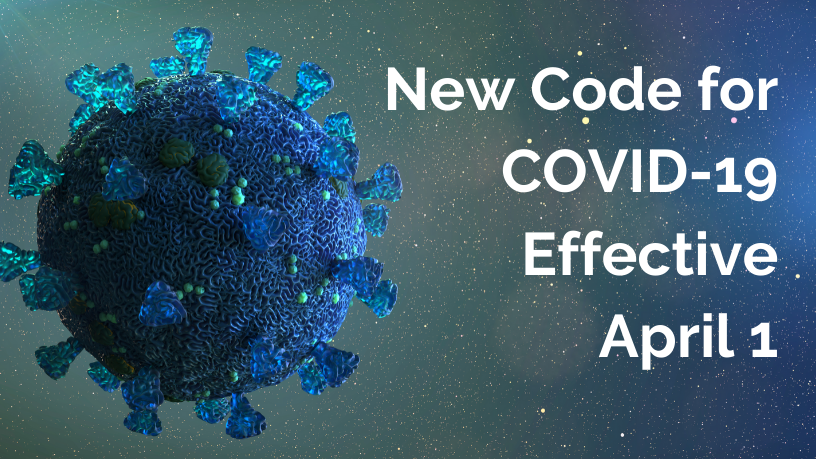The new code for COVID-19, U07.1, is one of two new codes to be added to the code set effective April 1, 2020. New codes are usually effective on October 1, except in the case of emergency, so we will have two codes in the new U chapter, one for COVID-19 and one related to vaping. There is currently no U chapter in the coding manual.
In the interim, the Centers for Disease Control and Prevention (CDC) has instructed healthcare providers to use code B97.29. Other coronavirus as the cause of diseases classified elsewhere, to report confirmed cases of COVID-19. Because code B97.29 is not exclusive to the SARS-CoV-2/2019-nCoV virus responsible for the COVID-19 pandemic, the CDC is urging providers to consider developing facility-specific coding guidelines that limit the assignment of code B97.29 to confirmed COVID-19 cases and preclude the assignment of codes for any other coronaviruses. The code currently represents more than 30 varieties of coronaviruses, some of which are responsible for the common cold.
The new code, U07.1, COVID-19, is to be used only as a primary diagnosis and is to be followed by other codes to indicate the complications or manifestations of the coronavirus (for example, pneumonia). The code is to be used for confirmed COVID-19 only and not for suspected cases. There are no Z codes for suspected cases or exposure of COVID-19. If the provider documents “suspected”, “possible” or “probable” COVID-19, do not assign code B97.29 or U07.1. Assign code(s) explaining the reason for encounter (such as fever), and/or Z20.828, Contact with and (suspected) exposure to other viral and communicable diseases.
Presumptive does not have the same meaning as suspected, possible or probable. The COVID-19 code should be used in the case of presumptive positive tests. A presumptive positive test result means an individual has tested positive for the virus at a local or state level, but it has not yet been confirmed by the CDC. CDC confirmation of local and state tests for the COVID-19 virus is no longer required. The provider, i.e., physician’s diagnostic statement that the patient has COVID-19 is enough documentation to use the code.
Considering that the U07.1 code is not effective until April 1 and healthcare providers are seeing cases now, it is important to note that the U07.1 code will not be made retroactive. The code is used for discharges and services beginning April 1. In the case of home health, new codes are effective as of the date of claim.
Some folks have suggested or asked about the appropriateness of using the diagnosis code B34.2: Coronavirus infection, unspecified. This code would generally not be appropriate for the COVID-19, because the cases have universally been respiratory in nature, so the site of infection would not be “unspecified.”
Coders should not use any of the other coronavirus codes with the new code for COVID-19. An Excludes1 note (meaning you cannot use the codes together) appears with U07.1 for:
- Coronavirus infection, unspecified (B34.2).
- Coronavirus as the cause of diseases classified elsewhere (B97.2-).
- Pneumonia due to SARS-associated coronavirus (J12.81).
Home health
CMS will add the new code U07.1 to the clinical grouper by mid-April. It was originally planned for July implementation with the new code for conditions related to vaping (U07.0) but will be moved up to April. A correction to CR 11656 will follow to reflect those changes. Both codes will be placed in the MMTA—Respiratory group.
Skilled nursing facilities
- Awaiting update from CMS
- https://www.cdc.gov/nchs/data/icd/ICD-10-CM-Official-Coding-Gudance-Interim-Advice-coronavirus-feb-20-2020.pdf
- https://www.cdc.gov/nchs/data/icd/ICD-10-CM-April-1-2020-addenda.pdf
Lisa Selman-Holman, JD, BSN, RN | President, Selman-Holman, a Briggs Healthcare Company


Comments
Thank you Lisa
Thank You!!
Complex nursing is actually one of the lowest-paying groupers. Place it first or second if the care provided is related only to care of the line. If there are other choices, i.e., wound care, that is a much better choice. CMS would like us to place the Z45.2 down farther in our listing so that they can pick it up for data purposes.
So will this code map for primary dx for pdpm or will it be a return to provider code?
Yes, it will be acceptable in I0020B as Pulmonary. It was posted tonight!
Can U07.1 be a primary diagnosis under PDGM?
Yes U07.1 is in the primary grouper for MMTA-Respiratory. It was just posted in the grouper tonight (wasn’t expected it until April 7).